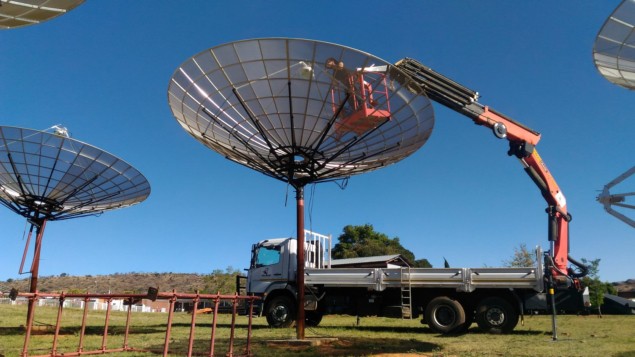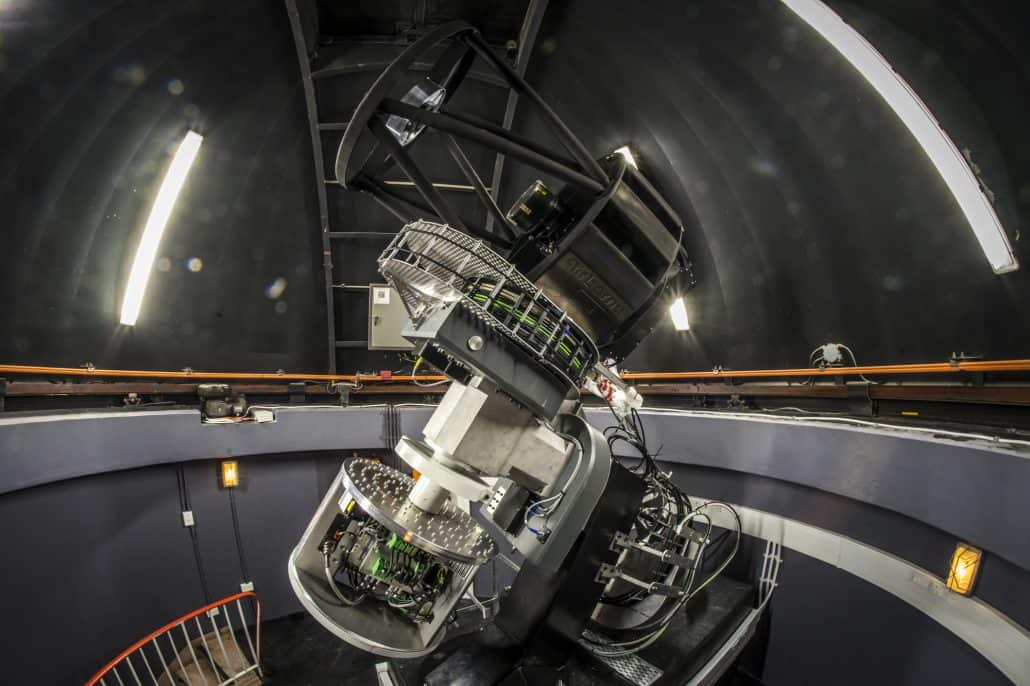Green light for South African radio telescope
 Eye on the sky: the Hydrogen Intensity and Real Time Analysis Experiment will study dark energy and fast radio bursts when fully operational in 2020 (Courtesy: Cynthia Chiang)
Eye on the sky: the Hydrogen Intensity and Real Time Analysis Experiment will study dark energy and fast radio bursts when fully operational in 2020 (Courtesy: Cynthia Chiang)
South Africa has given the go-ahead for a radio telescope that will study dark energy, detect fast radio bursts as well as track neutral hydrogen gas on cosmic scales. Costing R70 million ($5m), the Hydrogen Intensity and Real Time Analysis eXperiment (HIRAX) will consist of 1024 dishes, each 6 m in diameter, located in the Karoo region of South Africa and will map about a third of the sky during four years of operation.
One of the main aims of HIRAX will be to pinpoint the location of fast radio bursts – high-energy astrophysical phenomenon that consist of millisecond radio pulses. “The origin of these flashes is still a mystery,” says Kavilan Moodley, HIRAX team principal investigator. “They’re hard to detect and localize since they’re so brief and most telescopes only observe a small region of the sky.” HIRAX’s large field of view will allow astronomers to observe large portions of the sky daily so, in principle, when the flashes happen the instrument will be more likely to see them.
[HIRAX and MeerKAT] could give us a fuller view of some phenomena than one telescope alone could doFernando Camilo
Since 2016 researchers have been testing eight prototype dishes at the Hartebeesthoek Radio Astronomy Observatory (HartRAO) outside of Johannesburg. Yet during investigations they identified the need to limit interference so changed the focal ratio – a ratio of the telescope’s focal length to its diameter – of the dishes to 0.25 compared to 0.38.
Engineers are now working to design and build four new prototypes with the smaller focal ratios to install at HartRAO by the end of the year. Engineers will then construct an eight-dish prototype followed by a 128-dish “pathfinder” in the Karoo later next year. A further 512 dishes will be added to the array in early 2020 with the remainder being put in place later that year.
A fuller view
When fully operational, HIRAX will require a petascale computer to process up to 6.5 terabits of data per second as well as infrastructure to compress this data by a factor of 50–100. Moodley adds that the project will lead to many benefits for South Africa such as being used to train students, attract foreign scientists as well as increase collaboration with industry.
Although HIRAX has been developed independently from other radio telescopes such as the MeerKAT radio telescope also located in the Karoo, there will be some overlap in what they study. “Both telescopes could give us a fuller view of some phenomena than one telescope alone could do,” says Fernando Camilo, chief scientist at the South African Radio Observatory. HIRAX’s lowest operating frequency is 400 MHz – much less than MeerKAT’s 580 MHz – and according to Camilo that will let it see further back in time.READ MORE

The project has so far secured $1.4m from the University of KwaZulu Natal and South Africa’s National Research Foundation. Officials are now looking for funding sources for the remainder of the cash to complete the project.
6/9/2018 FROM PHYSICSWORLD.COM
Δεν υπάρχουν σχόλια:
Δημοσίευση σχολίου